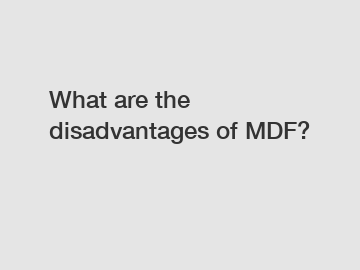Dec. 29, 2023
Construction
In the world of interior design and furniture making, Medium-Density Fiberboard, commonly known as MDF, has gained significant popularity due to its cost-effectiveness and versatility. MDF is an engineered wood product made by breaking down hardwood or softwood residuals into wood fibers. While MDF has its advantages, it is essential to acknowledge its limitations and potential downsides to make informed decisions. In this blog, we will delve into the disadvantages of MDF, providing a comprehensive view for consumers and professionals alike.
1. Lack of Durability.
One of the primary drawbacks of MDF is its susceptibility to moisture. When exposed to water or high humidity, MDF tends to swell, warp, or even break down. This vulnerability makes it unfit for areas such as kitchens, bathrooms, or any space prone to moisture. Furthermore, MDF's density makes it fragile, as it can easily crack or split under excessive pressure or impact.

2. Limited Load-Bearing Capacity.
MDF's structure makes it less resilient compared to natural wood or other solid wood products. It is not suitable for applications that require significant load-bearing capacity, such as heavy furniture or large structural components. The lack of strength in MDF restricts its use to lighter tasks and decorative purposes, undermining its suitability for long-lasting and durable projects.
3. Environmental Concerns.
While MDF is a cost-effective alternative to solid wood, its production involves the use of various chemicals, adhesives, and resins, that can emit volatile organic compounds (VOCs). VOCs contribute to indoor air pollution and pose health risks. Additionally, the manufacturing process of MDF involves deforestation and requires energy-intensive procedures, potentially impacting the environment. Those concerned about ecological sustainability may hesitate to choose MDF due to these environmental implications.
4. Limited Aesthetic Appeal.
MDF lacks the natural wood grain patterns and unique charm present in solid wood. Its uniform surface texture may leave some homeowners longing for the distinctive character that only genuine timber brings. While laminates and veneers can be applied to enhance the appearance of MDF, these additions come at an additional cost, diminishing the material's relative affordability.
5. Challenging Repairs.
Accidents happen, and furniture often requires repairs or refinishing over time. However, fixing damaged MDF poses a challenge. Unlike solid wood, MDF cannot be sanded down or restored as easily. Once damaged, it is difficult to restore the material back to its original state, often resulting in the need for complete replacement. This lack of reparability can be a significant drawback for those looking to extend the lifespan of their furniture.
Conclusion.
While MDF has its merits, it is important to understand its limitations and disadvantages when considering its use. The material's susceptibility to moisture, limited load-bearing capacity, environmental concerns during production, and lack of reparability are drawbacks that should be thoroughly considered and evaluated. As consumers and professionals in the industry, it is important to weigh the benefits and disadvantages of any material before making design and construction decisions.
By being aware of the downsides, individuals can make informed choices, exploring alternatives if necessary, to ensure their projects meet their long-term expectations. In the end, the goal is to strike a balance between functionality, affordability, and sustainability, while delivering aesthetically pleasing and durable results.
Want more information on grey melamine plywood, furniture grade birch plywood, marine plywood for trailer floor? Feel free to contact us.
Previous: Is it really cheaper to build a container home?
Next: What is honey quartz?
If you are interested in sending in a Guest Blogger Submission,welcome to write for us!
All Comments ( 0 )